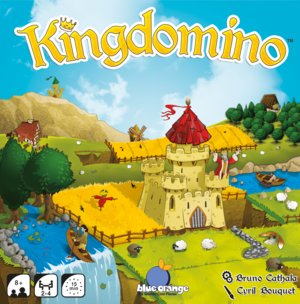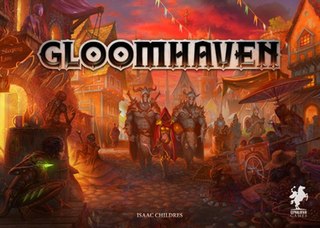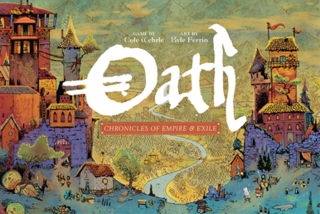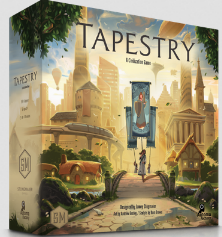
Pandemic is a cooperative board game designed by Matt Leacock and first published by Z-Man Games in the United States in 2008. Pandemic is based on the premise that four diseases have broken out in the world, each threatening to wipe out a region. The game accommodates two to four players, each playing one of seven possible roles: dispatcher, medic, scientist, researcher, operations expert, contingency planner, or quarantine specialist. Through the combined effort of all the players, the goal is to discover all four cures before any of several game-losing conditions are reached.

A legacy game is a variant of tabletop board games in which the game itself is designed, through various mechanics, to change permanently over the course of a series of sessions.

Kingdomino is a 2016 tile board game for 2-4 players designed by Bruno Cathala and published by Blue Orange Games. In this 15-20 minute, family-oriented game, players build a five by five kingdom of oversized domino-like tiles, making sure as they place each tile that one of its sides connects to a matching terrain type already in play. The game was critically successful and won the 2017 Spiel des Jahres award, and was followed by several spin-offs and expansions.

Terraforming Mars is a board game for 1 to 5 players designed by Jacob Fryxelius and published by FryxGames in 2016, and thereafter by 12 others, including Stronghold Games. In Terraforming Mars, players take the role of corporations working together to terraform the planet Mars by raising the temperature, adding oxygen to the atmosphere, covering the planet's surface with water and creating plant and animal life. The game incorporates elements of resource management, engine building, and strategic planning. Players compete to earn the most victory points, which are measured by their contribution to terraforming and to human infrastructure. These goals are achieved by collecting income and resources which allow them to play various projects, represented by cards that increase their income or resources, build infrastructure, or directly contribute to terraforming the planet. The game was received positively by fans and critics, and received numerous awards.

Star Wars: Rebellion is an asymmetrical strategy board game designed by Corey Konieczka and published by Fantasy Flight Games in 2016. The game's setting is inspired by the original Star Wars trilogy. Players control either the Galactic Empire or the Rebel Alliance. Each player pursues a different path to victory, with the Galactic Empire playing seeking to find the Rebel Alliance player's base and destroy it, while the Rebel Alliance player attempts to avoid detection by the Galactic Empire and sabotage their efforts. The game received highly positive reviews and won numerous awards.

Gloomhaven is a cooperative board game for one to four players designed by Isaac Childres and published by Cephalofair Games in 2017. It is a campaign-based dungeon crawl game including a narrative campaign, 95 unique playable scenarios, and 17 playable classes. Since its introduction the game has been acclaimed by reviewers, and has been described as one of the best board games ever made.

Charterstone is a board game for 1-6 players designed by Jamey Stegmaier and released by Stonemaier Games in 2017.Players work together over a twelve game campaign to build a village, while simultaneously competing to win each game, and ultimately win the campaign. Chartersone was designed as a "legacy board game" meaning that each game played influences, or leaves a legacy, for subsequent games within a larger campaign.
Jakub Różalski, also known as Mr. Werewolf, is a Polish artist. He is best known as the illustrator of the board game Scythe and related paintings, commonly featuring mythical, fantastical beasts, robots and similar concepts. His style combines the classic art style of late 18th and early 19th century paintings with modern fantasy and science fiction concepts.

Wingspan is a board game designed by Elizabeth Hargrave and published by Stonemaier Games in 2019. It is a card-driven, engine-building board game in which players compete to attract birds to their wildlife reserves. During the game's development process, Hargrave constructed personal charts of birds observed in Maryland, with statistics sourced from various biological databases; the special powers of birds were also selected to resemble real-life characteristics. Upon its release, Wingspan received critical and commercial acclaim for its gameplay, accurate thematic elements, and artwork. The game also won numerous awards, including the 2019 Kennerspiel des Jahres. Several expansions and a digital edition have been subsequently published.

Iron Harvest is a real-time strategy video game developed by King Art Games and published by Deep Silver. Players control mecha in a dieselpunk setting. The game was released for Windows on September 1, 2020. PlayStation 5 and Xbox Series X/S on October 26, 2021.

Spirit Island is a euro-style co-operative strategy board game designed by R. Eric Reuss and published by Greater Than Games in 2017. Digital versions have been released for PC, iOS, and Android.
The Crew: The Quest for Planet Nine is a board game for 3–5 players designed by Thomas Sing and released in 2019. In The Crew, a trick-taking cooperative card game with 50 missions, players aim to win tricks based on their task cards, but can only communicate limited information on their cards. Upon its release, The Crew received critical success and won numerous awards. A sequel, The Crew: Mission Deep Sea, was released in 2021.

Root: A Game of Woodland Might and Right is a 2018 asymmetric strategy wargame board game designed by Cole Wehrle, illustrated by Kyle Ferrin, and published by Leder Games. In Root, players compete for the most victory points through moving and battling using various factions with unique abilities. Upon its release, Root received positive reviews, and was followed by four expansions. A digital version, developed by Dire Wolf Digital, was released in 2020.

Leder Games is a board game developer owned by Patrick Leder and based in Saint Paul, Minnesota, United States. It is best known for publishing asymmetric games such as Root and Oath: Chronicles of Empire and Exile, which were both designed by Cole Wehrle. As of 2023, board games released by the company have usually been illustrated by Kyle Ferrin.
Tellstones: King's Gambit is a 2020 tabletop game created by Riot Games under their Riot Tabletop division. Two or four players take turns placing, swapping, and guessing tokens; the goal of the game is to either guess three tokens correctly or "boast" successfully by correctly guessing all hidden tokens. Developed as part of Riot's expansion into games outside League of Legends, the game is the company's second tabletop product following their 2016 release Mechs vs. Minions. Tellstones was released in September 2020; reviewers praised the game for its presentation and build quality, but criticized its gameplay as short and uninteresting.

Sagrada is a dice-drafting board game designed by Adrian Adamescu and Daryl Andrews and published in 2017 by Floodgate Games. Each player constructs a stained-glass window using dice on a personal 4×5 game board board with restrictions on the types of dice that can be played on each space. Players gain points by completing public and secret objectives for dice placements, and the one with the most after ten rounds is the winner.
Viticulture is a worker placement board game published by Stonemaier Games in 2013. The game's design was crowdfunded via a campaign on Kickstarter, with the concept of players building an Italian vineyard. Upon its release, Viticulture received praise for its engagement, but its luck was critiqued. Several expansions and reprints were later released.

Oath: Chronicles of Empire and Exile is a 2021 board game with asymmetric gameplay and legacy elements designed by Cole Wehrle, illustrated by Kyle Ferrin, and published by Leder Games. In Oath, players compete to become the Chancellor, and the events of each game influence the events of the games that follow. Upon its release, Oath received positive reviews, and an expansion for the game is in development. The game is part of an increase in the release of games that are based on a scenario or have a campaign structure, and is focused on fantasy politics and crisis.

Tapestry is a 2019 strategy board game designed by Jamey Stegmaier and published by Stonemaier Games.

Wyrmspan is a board game for one to five players designed by Connie Vogelmann and published by Stonemaier Games in 2024. It is a card-driven, engine-building board game in which players compete to excavate labyrinths and entice dragons to the sanctuary of their caves. Based on the acclaimed board game Wingspan, Wyrmspan is themed around dragons instead of birds and hosts slightly more complex game mechanics. Upon its release Wyrmspan received widespread positive reviews and achieved the largest single-day product sale quantity in Stonemaier Games history.

















